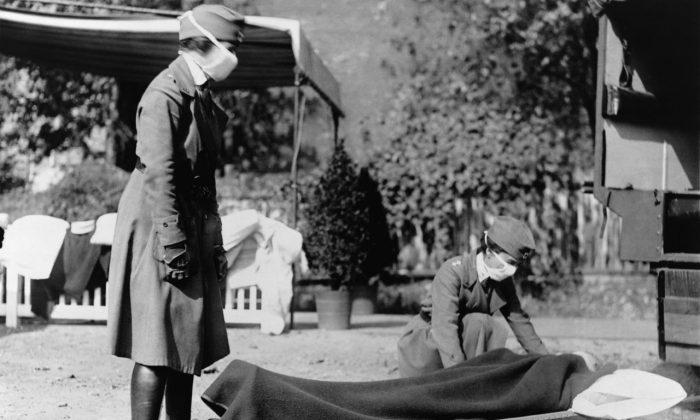The origin of the 1918 flu virus and why it was able to infect more than one-third of the world’s population and kill more than 50 million people has been a mystery until now.
Michael Worobey, professor in the ecology and evolutionary biology department at the University of Arizona, and his colleagues have developed an unprecedentedly accurate “molecular clock” approach to untangle the origins of the 1918 pandemic H1N1 influenza A virus—the classic swine H1N1 influenza virus—and the post-pandemic seasonal H1N1 lineage that circulated from 1918 until 1957.
A molecular clock is a technique used in evolutionary biology to reconstruct family trees of organisms—or viruses—based on the number of genetic mutations accumulating over time.
The researchers discovered that the pandemic virus arose shortly before 1918, when a human H1 virus, which they infer had already been circulating in the human population since about 1900, picked up genetic material from a bird flu virus.
The human influenza A virus usually sees higher mortality rates for infants and the elderly, but the pandemic virus caused extensive deaths in people ages 20 to 40, primarily from secondary bacterial infections, especially pneumonia.
This likely was because many young adults born from about 1880 to 1900 were exposed during childhood to a putative H3N8 virus circulating in the population, which had surface proteins that were very different from those of the H1N1 virus, researchers suggest. In contrast, most individuals born earlier or later than 1880 to 1900 would have had better protection because they were more likely to have been exposed a virus variant more similar to the 1918 virus.
LOLLIPOP-STUDDED SOCCER BALL
“You can picture the flu virus as a tiny soccer ball studded with lollipops,” Worobey says. “The candy part of the lollipop is by far the most potent part of the flu virus, against which our immune system can make antibodies. If antibodies cover all the lollipop heads, the virus can’t even infect you.”
For example, a person exposed to a flu strain studded with blue candy lollipops would have antibodies protecting it from future infections with that flu virus. However, if faced with a different strain containing red candy, that same person would get sick because the “anti-blue” antibodies would not recognize the red lollipops, allowing the virus to slip through the body’s immune defenses unscathed.
“We believe that the mismatch between antibodies trained to H3 virus protein and the H1 protein of the 1918 virus may have resulted in the heightened mortality in the age group that happened to be in their late 20s during the pandemic,” Worobey says.
BIRD FLU DEATHS
Reported in the early edition of the Proceedings of the National Academy of Sciences, the new perspective applies not only to the pandemic of 1918, but might also explain patterns of seasonal flu mortality and the mysterious patterns of mortality when humans are infected by highly pathogenic avian-origin H5N1 and H7N9 viruses, commonly known as the “bird flu.”
H5N1 causes higher mortality rates in young people, and H7N9 causes higher mortality in the elderly. In both cases, the researchers found that the more susceptible age groups were exposed initially, as children, to viruses with a mismatched HA, and may suffer severe consequences similar to young adults faced with a mismatched virus in 1918.
The authors suggest that immunization strategies mimicking the often impressive protection provided by initial childhood exposure to influenza virus variants encountered later in life might dramatically reduce mortality due to both seasonal and novel IAV strains.
Earlier this year, Worobey and his collaborators published a study in the journal Nature providing the most comprehensive analysis to date of the evolutionary relationships of flu virus across different host species over time.
The results revealed a rapid, global replacement of the genes in the avian flu virus coinciding closely with a horse flu outbreak in the 1870s that crippled the economy. They also challenged the accepted wisdom of wild birds as the major reservoir harboring the flu virus, from where it jumps to domestic birds and other species, including humans. Instead, the researchers found a very strong indication of spillover from domestic birds to wild birds.
Guan-Zhu Han of the ecology and evolutionary biology department and Andrew Rambaut at the Centre for Infection, Immunity and Evolution at the University of Edinburgh are coauthors on the study. The National Institutes of Health provided funding.
Source: University of Arizona
Republished from Futurity.org under Creative Commons license 3.0. Read the original.



Friends Read Free